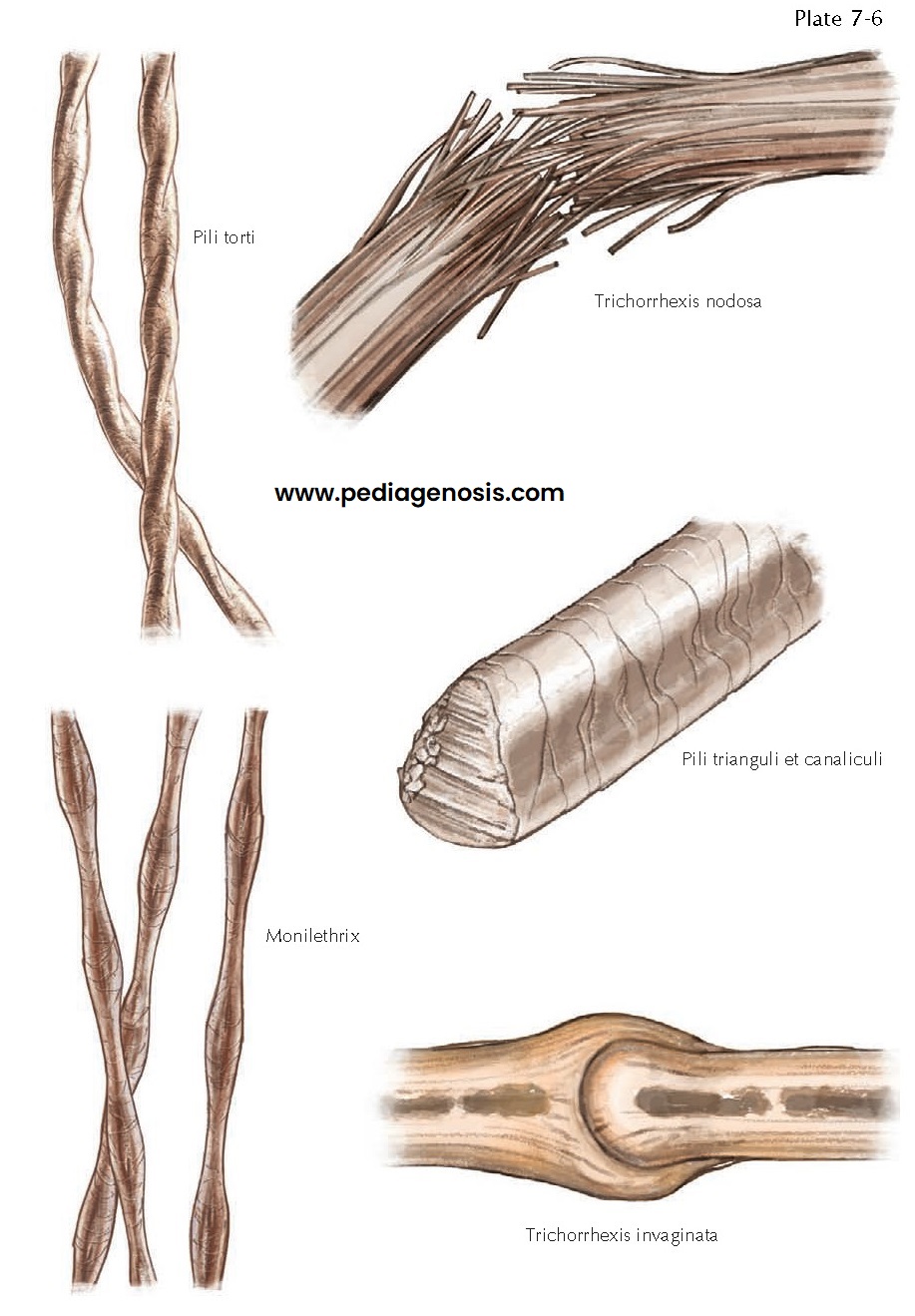HAIR SHAFT ABNORMALITIES
There are a wide variety of hair shaft abnormalities. Most are nonspecific clinical findings that can be seen in a multitude of underlying conditions, as well as in the normal individual. Trichoptilosis, known by the lay term “split ends,” is probably the most common hair shaft abnormality in humans. It is nonspecific and is not associated with any particular underlying syndrome. Trichoptilosis is believed to be caused by excessive trauma to the distal hair shaft. Trichorrhexis nodosa is another hair shaft abnormality that can be seen in individuals with no underlying disease state. A few highly specific hair abnormalities are indicative of particular disorders; for example, pili trianguli et canaliculi and trichorrhexis invaginata are seen only in uncombable hair syndrome and Netherton syndrome, respectively. The astute clinician uses knowledge of hair shaft abnomalities to help form a differential diagnosis and in some cases to confirm a diagnosis.
Pili
torti is also known as “twisted hair” or “cork- screw hair.” The hair twists on
its axis in a corkscrew pattern. This twisting leads to increased pressure on
the hair shaft, which results in early breakage and short, brittle hair. The
involvement is almost exclusively on the scalp. Pili torti is nonspecific and
can be found in a number of genetic skin conditions, including Björnstad
syndrome, Menkes syndrome, and Crandall syndrome. It can also be seen as a primary
hair disease with no underlying associations.
Monilethrix
is a highly specific hair shaft abnormality. The hair has a beaded or
undulating appearance, with nodes interspaced at regular intervals by
abnormally thin hair. It is inherited in an autosomal dominant fashion and is
caused by a mutation in the hair basic keratin 6 gene ( HB6), which is
officially known as keratin 86 (KRT86). The hair is fragile and breaks
in the thinned internode regions. The internode regions are devoid of pigment,
and this feature is used to discriminate this condition from
pseudo-monilethrix. There is no known therapy. Many afflicted individuals
improve after puberty. It is almost never associated with systemic disease.
Trichorrhexis
nodosa is a completely nonspecific finding that may be seen in healthy
individuals. This hair shaft abnormality has been described as “broom-stick
hair” because of the appearance of the distal end of the broken hair, which
resembles the bristles of a broom. Trichorrhexis nodosa is the most frequent
reason for hair breakage. Trauma to the hair is causative. This trauma can be
self-induced by rubbing or twisting, which results in fracturing of the hair
and the appearance of trichorrhexis nodosa. This finding on microscopic
examination can be helpful in evaluating hair loss secondary to
trichotillomania or chemical-induced alopecia.
Pili
trianguli et canaliculus, also termed “spun glass hair,” is the diagnostic
finding in uncombable hair syndrome. This rare and highly unusual syndrome is
associated with no underlying ill effects on the afflicted individuals. The
hair is uncontrollable and impossible to comb straight. This effect is related
to the abnormal triangular shape of the hair shaft as well as changes in the
direction of the hair, which occur at uneven intervals. The condition is
inherited in an autosomal dominant pattern and is believed to be the result of
an abnormal inner root sheath. No therapy is needed, and most children with
this condition spontaneously improve over time. The hair shafts appear almost
tri-angular under electron microscopy.
Trichorrhexis invaginata is seen only in patients with the autosomal recessive Netherton syndrome. This hair shaft abnormality has been termed “bamboo hair” because of its resemblance to the growth rings of a bamboo plant. Another descriptive term is “ball and socket hair,” because it appears that the distal portion of the hair invaginates into the proximal hair cortex. The hair is brittle and breaks easily, leading to alopecia. The eyebrow hair is the best place to look for trichorrhexis invaginata. Netherton syndrome is a multisystem disease caused by a mutation in the SPINK5 gene that is associated with erythroderma, alopecia, and elevated levels of immunoglobulin E. Ichthyosis linearis circumflexa is the name for the migratory, irregular, serpiginous patches and plaques with a double-edged scale that are seen only in Netherton syndrome. The SPINK5 gene encodes the serine protease inhibitor, Kazal type 5 protein, which is important in epithelial desquamation.





